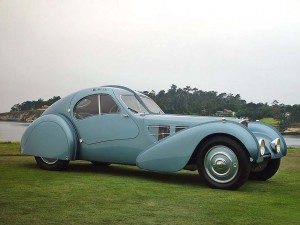
With a price tag reportedly running near to $40 million, this 1936 Bugatti Type 57SC is now the world's most expensive automobile.
While we may never know the exact price paid for what is known as the Williamson Bugatti, the rumored price tag of nearly $40 million will handily make it the most expensive automobile in the world.
More formally a 1936 Bugatti Type 57SC Atlantic, this rare example of rolling French art deco styling was sold at a private auction, sometime last week, by the California-based auction house, Gooding & Company. Details of the transaction aren’t being released but insiders hint the price tag was somewhere between $30 million and $40 million, which would handily exceed the previous record price paid for a car classic.
In May 2009, a 1957 Ferrari Testa Rossa was gaveled off for $12.2 million at an auction near the company’s headquarters, in Maranello, Italy.
The Atlantic, which won the prestigious Pebble Beach Concours d’Elegance, in 2003, was reportedly sold to the Mullin Automotive Museum, in Oxnard, CA. It had previously been owned by the late Dr. Peter Williamson, a noted neurologist whose collection specialized in Bugattis. After his death, in 2008, Williamson’s estate began selling off the collection, some of which went for a collective $15.5 million at a Gooding Auction at Pebble Beach in August of that year.
But the Atlantic was considered the prize of the Williamson Bugattis, which were kept at his home in Lyme, Connecticut, and the auction house – which had had originally helped Williamson amass his enviable collection, kept looking for a private buyer, a common practice in the collector world.
Perhaps no automotive brand is more storied than Bugatti, which was founded by Ettore Bugatti. Between the wars, he and his son, Jean, produced a series of exotic sedans, coupes and convertibles that were coveted by royalty and the rich. They featured some of the most advanced technology of the day but, more importantly, some of the most striking designs ever molded into sheet metal.
The 1936 Bugatti Type 57SC Atlantic was a revised version of the Aerolithe Electron Coupe Jean Bugatti produced for the 1935 Paris Auto Salon. The concept vehicle featured magnesium body panels. The three production vehicles that followed used aluminum but maintained the Aerolithe’s distinctive seams.
“I am extremely pleased to have found the new buyer for the 1936 Bugatti Type 57SC Atlantic, one of the world’s most significant and valuable automobiles that has been in a private collection and rarely seen during the past four decades,” said David Gooding, president and founder of Gooding & Company.
Gooding declined to provide details of the sale but if the reports circulating among high-level sources prove correct, the Atlantic could seen be available for public viewing at the Mullin Museum, which is located roughly an hour north of Los Angeles.
The Bugatti business collapsed as World War II approached, and with the death of both Ettore and Jean, was never able to pull itself back together, though an attempted revival, in the 1950s, led to the production of one new car. The firm shifted its focus to airplane parts and, eventually, the remains of the firm were sold off.
Efforts were made to revive the brand in the 1980s, and a small number of the EB110 sports car were produced in the ‘90s, the 2-seater developed by the same stylists who came up with the legendary Lamborghini Countach. The venture ultimately failed. But in 1998, Volkswagen AG bought the rights to the Bugatti marque and a year later revealed what would become the Bugatti EB 16.4 Veyron.
Billed as the world’s fastest production vehicle, at 253 mph, the Veyron and several spin-offs carry price tags of as much as $2.3 million. Production is expected to soon wind down and VW officials say they are preparing a replacement for the Veyron.
